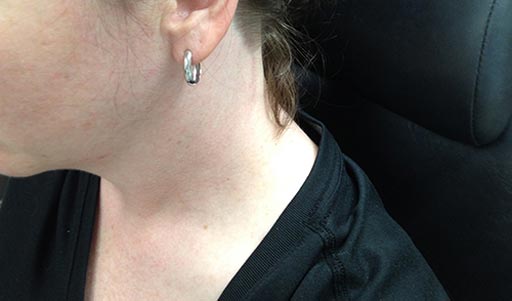Novel Thyroidectomy Technique Leaves Almost No Scar
By HospiMedica International staff writers
Posted on 28 Feb 2017
A new study describes the retro-auricular surgical approach,which allows thyroid lobectomy without robotic or endoscopic assistance.Posted on 28 Feb 2017
Developed by researchers at Louisiana State University Health Sciences Center (LSUHSC), the technique involves a modified incision of the standard face-lift approach, which optimizes incision placement by placing it inside the hairline and in a natural skin crease. The researchers conducted a 18-month retrospective chart review that identified 10 patients (all female, average 36 years of age) who underwent the retro-auricular thyroidectomy procedure in the absence of robotic or endoscopic assistance. Six of the procedures were right sided, and four were left sided.

Image: A new thyroidectomy approach is virtually scarless (Photo courtesy of Dr. Rohan Walvekar).
The average operative time was 91 minutes, with no conversions to open cervical thyroidectomy; two patients had vocal cord paresis that resolved spontaneously. The average gland size was 4.2 cm, and the average nodule size 2.1 cm. During postoperative follow-up of three months, the researchers concluded that retro-auricular thyroidectomy is a safe, reproducible, and cost effective option for remote access thyroidectomy. The study was published on January 16, 2017, in the Indian Journal of Otolaryngology Head and Head & Neck Surgery.
“Our goal was to create an efficient, safe and cost effective approach that used standard surgical techniques and skills, making the approach reproducible and attractive to well-trained thyroid surgeons who may not have access to specialized equipment,” said lead author associate professor of otorhinolaryngology Rohan Walvekar, MD. “This approach is a cost effective option for patients seeking distant access thyroid surgery in an environment where health care resources and access to advanced technology are limited.”
Thyroidectomy involves the surgical removal of all or part of the thyroid gland due to cancer or some other condition of the thyroid gland, such as hyperthyroidism. Other indications for surgery include cosmetic reasons or symptomatic obstruction causing difficulties in swallowing or breathing. One of the complications of thyroidectomy is voice change, and patients are strongly advised to request protection of the voice by using electronic nerve monitoring.














